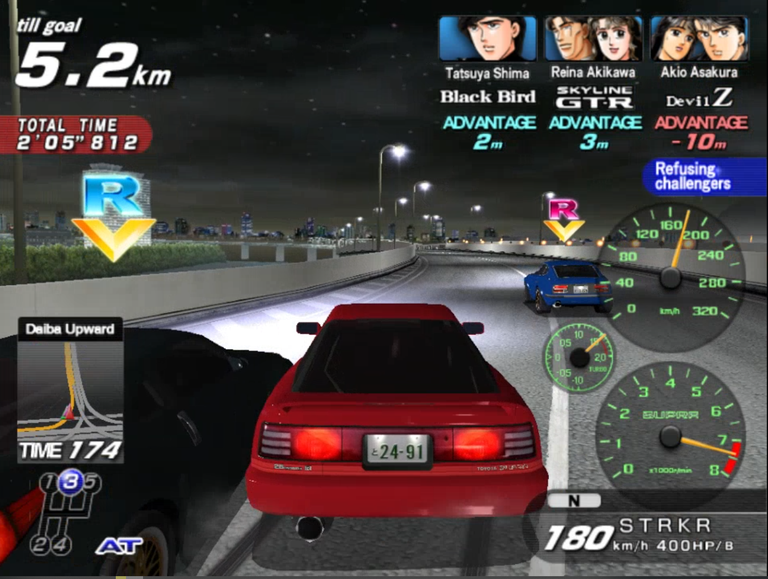

Some days ago, I had started watching the first episodes of the Wangan Midnight anime, which is considered kind of a competitor to Initial D that focuses in a very different aspect of street racing.
Putting aside the intricacies of each's story, the clear cut differences are Initial D being about street racing on mountain passes, leading to those highlights with drifting since said mountain passes have A LOT of turns - leading to a lot of drifts...and that is transferred to the Initial D games [or at least, the ones released since the first Arcade Stage] which often are about getting to drift those turns as best as you can.
But as Wangan Midnight instead focuses on high-speed driving at highways with highly tuned cars [mixed with stories about the implications of street racing, from things you sacrifice to potential consequences]...the arcade games also follow on this more straightforward racing style.
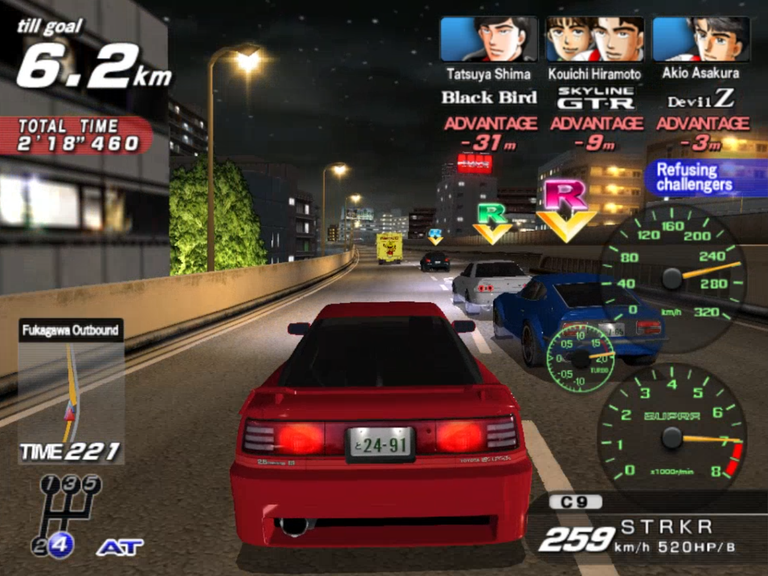
However, while there ARE some tracks in these games that have more turns than usual [like the Hakone mountain pass and the C1 line], the Wangan games are often about driving fast on straights, having to fight to keep control from racers pulling behind you as well as tackling subtle-but-long curves and a bunch of traffic driving at or behind you - either in 1v1 or four player races.
Unfortunately, similar to the Initial D Arcade Stage games in that beyond a few Japan-only games for PS2 and PS3, the Wangan games have zero availability outside of the arcades. In fact, the two Wangan Midnight games there are for PS2 and PS3 aren't even related to the Namco-made Maximum Tune series, instead being handled by Genki.
Bandai Namco would keep up with this series of Wangan games since 2004 up to this day, with a new variant of the sixth entry being released this year. But when I sometimes look up about these games, there seems to be some occasionally consistent praise for the third game in particular.
With this entry having this interesting appeal as well as landing square on the balance of resources for me [smaller in size than every entry onwards and being an older title so it should run well on my PC], I ended up making this the first entry I play of this series.
What does Maximum Tune 3 offer in modes?
As someone that hasn't played any of the previous titles, I'm ignoring any upgrades it may have done from the first two games, as well as the DX/DX+ upgrades for this game and sequels that came after it, so this will be going through what the game offered to me at face value without any previous or newer context at hand.
The game has a card system to keep track of your progress in the single player modes as well as the progress you do in tuning your car - something seen in the Initial D games as well as probably many others...although at least this one does let you change the transmission anytime you play instead of having to wait for a renewal like Initial D Arcade Stage 3 did.
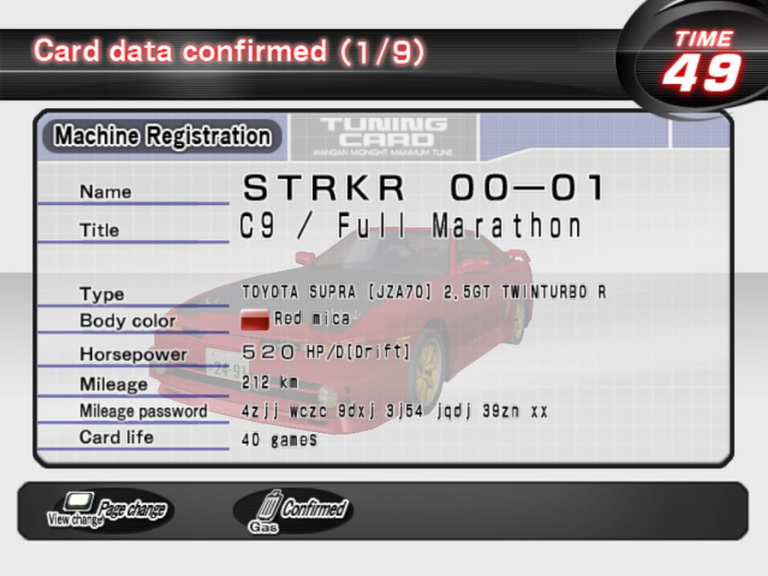
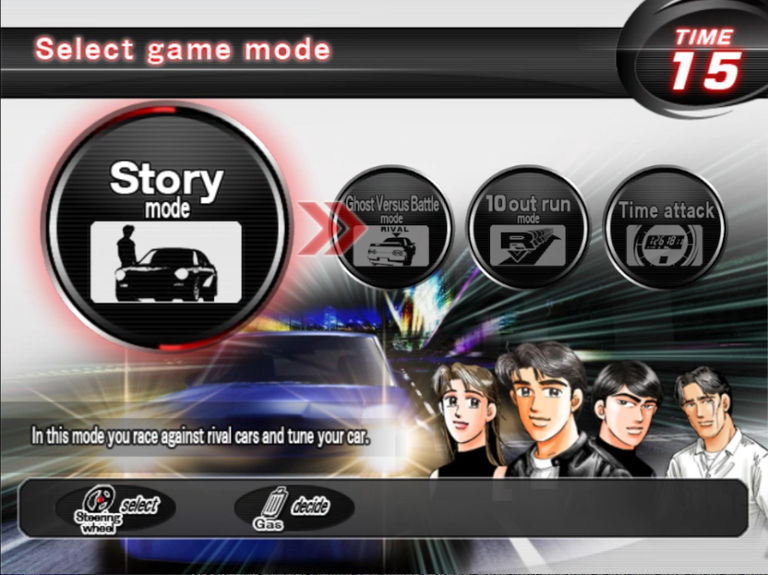
The modes at hand are:
- Story Mode: You race against several characters from the Wangan Midnight manga, somewhat loosely following events from it. It was actually interesting to recognize lines from the six or so first races I did due to how I had watched the anime.
- Ghost Battle: You race head to head against ghosts of other players - or at least if you were playing on a real cabinet and players left their ghosts to race against. If that's not the case, then you are pretty much racing against the game's included ghosts, but at least this mode lets you customize your car.
- 10 Outrun Mode: Unlike the other modes, here you choose a course and level of difficulty with different racers with a certain horsepower range...and then have to outrun 10 racers straight. It is executed in that you will be against a single racer and have to get ahead of them once [conveniently shown with a beam] to then be thrown against another racer.
- Time Attack: It's a time attack mode. Choose a course and go at it.
If you want to get your car up to speed, as well as getting to grips with how the game usually rolls, Story Mode is what you have to play - as with each succesful race, you'll have a chance to increase your Power or Handling.
Although if you focus on Power too much instead of doing both at a balanced pace [and I assume something similar happens if you ignore Power over Handling for long], you'll get this girl calling you off for that instead of the tuner characters that tell you what you're getting.
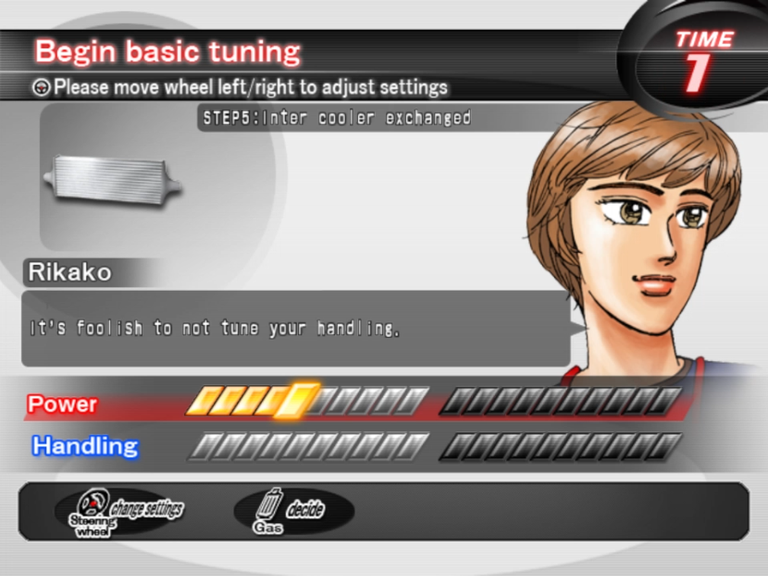
It is funny, but it is also a hint that repeatedly unbalanced Power upgrades will give you less HP until you get the corresponding Handling upgrades to get more power.
How things roll on the road
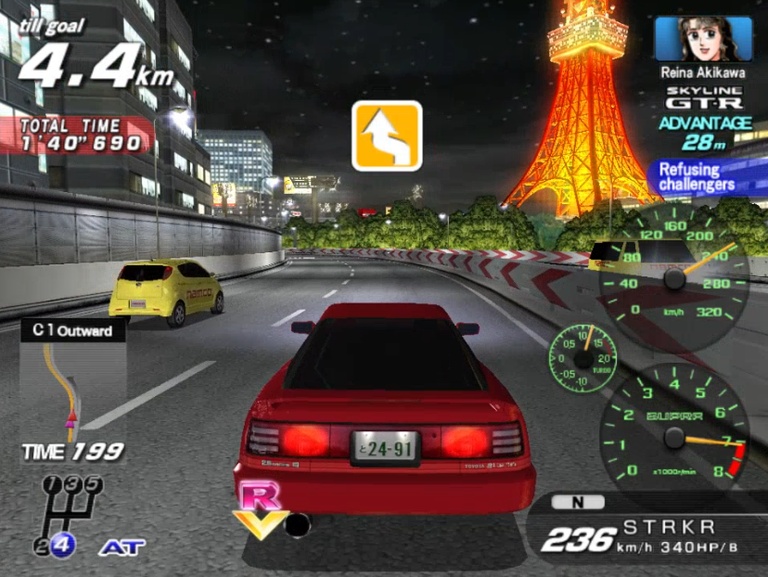
I have to first mention the little funny detail of how most traffic cars in this game are all yellow Namco-branded with Pac-Man decals, which at first seems like a very cheeky way of handsigning these games - but turns out that there's actually a blurb in Japanese versions of this [and the Export version of the first WM arcade game] that say that the events of this game are in 20XX - with these big highways being somehow cut off from the city's usual routes and are now for special racing.
...But it is still funny that, with or without context, you'll see all these bright yellow traffic cars driving besides you.
Moving on to the gameplay though, it seems simple at first with how most roads are pretty long straights and, if playing in Automatic, steering and accel/brake are all you have. But of course, tackling curves at high speeds will put your skill to test.
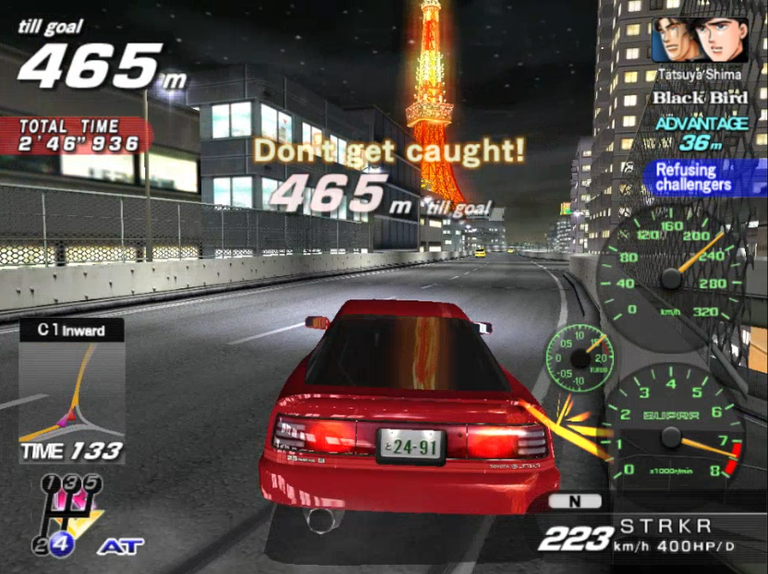
I don't know how to describe exactly the way the cars feel when they turn sharply, but feels like a middle point between being good enough to turn through high speed turns with the right lines and speed...but being kind of slippery enough to force you actually take your time learning to approach those curves, as otherwise you'll bump on the fence and lose speed.
With how the focus of this game is all about keeping speed, which is emphasized when you have to block any cars pulling behind you, speed losses through curves is an easy way to allow a rival that's breathing on your neck to jump ahead. But if you are lucky to have a traffic truck coming on the side of where the rival is trying to overtake you at, you can go for a very cheeky trick...
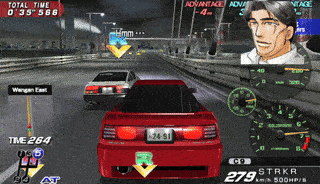
Out of pocket moves and the general constant chase mid-race is what has made those games to have a fanbase in arcades that have them, as there's a lot of push-and-pull between racers trying to overtake each other due to the length and integrated catch-up boost to allow players falling behind to get back.
So yeah, the guy I sent into a truck actually recovered fast and was actually mostly ahead of me after that...but he was doomed to blow his engine in that chapter so he fell behind anyways [and on the flipside, I have sometimes struck cars head first but then was able to catch up with the racers anyways 😂 ]
Throwing hands against ghosts
Imagine my reaction when one of the ghosts I could race here was named DTogo.
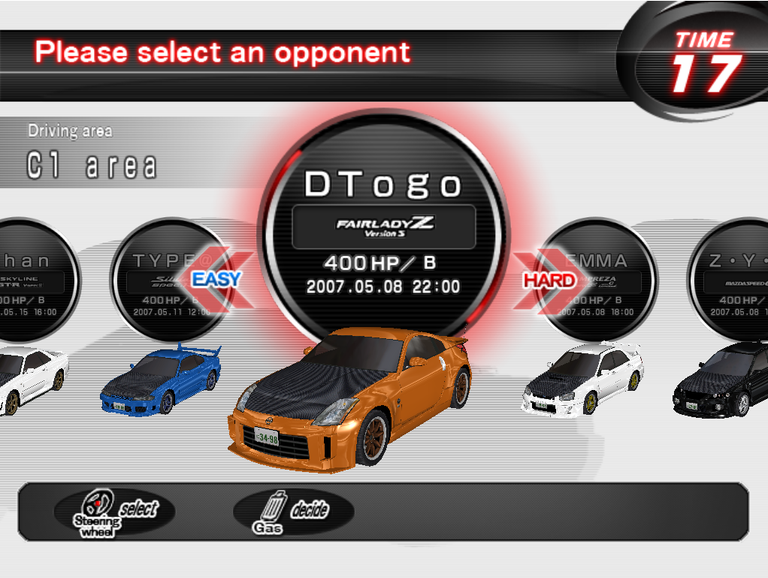
That is a reference to none other than Duke Togo...a.k.a. Golgo 13 - if the name doesn't ring a bell, it is a character from a VERY old manga that I found out from an arcade game...and I actually had talked about a movie of it at the start of the year.
But the ghost itself? Nothing threatening...I had 450HP when I tried Ghost Battle so I was kinda above its weight, but it definitely wasn't as fast as I expected.
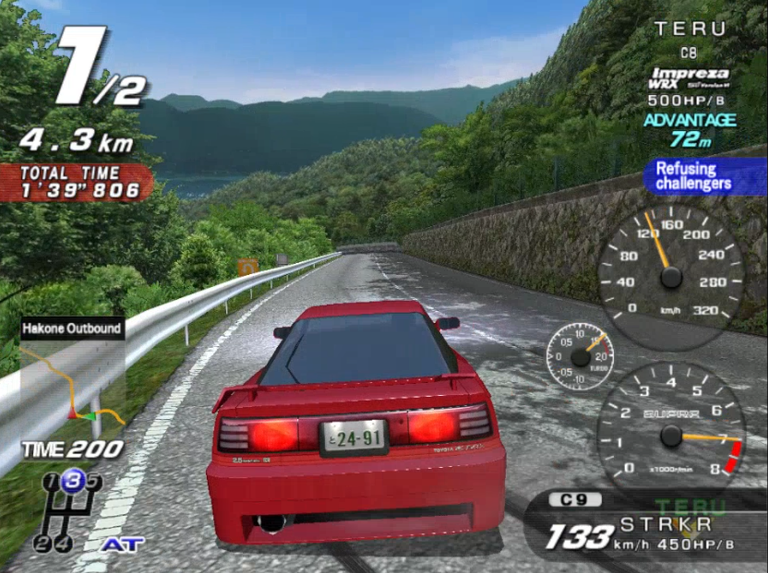
However, I did do two races against Level 3 ghosts, which were at 500HP, so they gave a better fight. While the Hakone ghost eventually fizzled out after I managed to keep it at bay in the first few minutes, the 500HP ghost at C1 gave a somewhat fair fight through and through.
In any case, if you want to get your car to look different with customization pieces, Ghost Battle is where you go instead, as you get new parts to swap in for each victory.
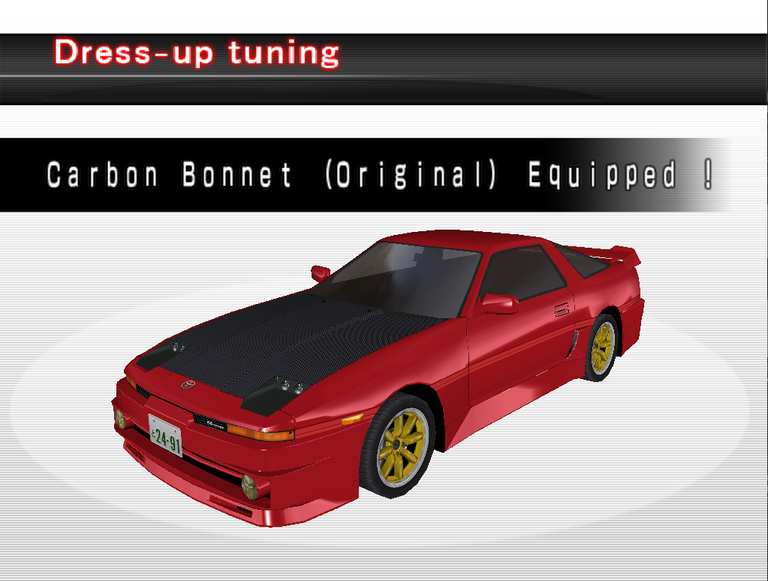
Conclusion
On one hand, it is kind of funny how you can arguably break the power scale of the easier levels at Ghost Battle and 10 Outrun mode if you play the story mode enough - but is a better alternative to do that than to foolishly aim for the high difficulty challenges without a tough enough car.
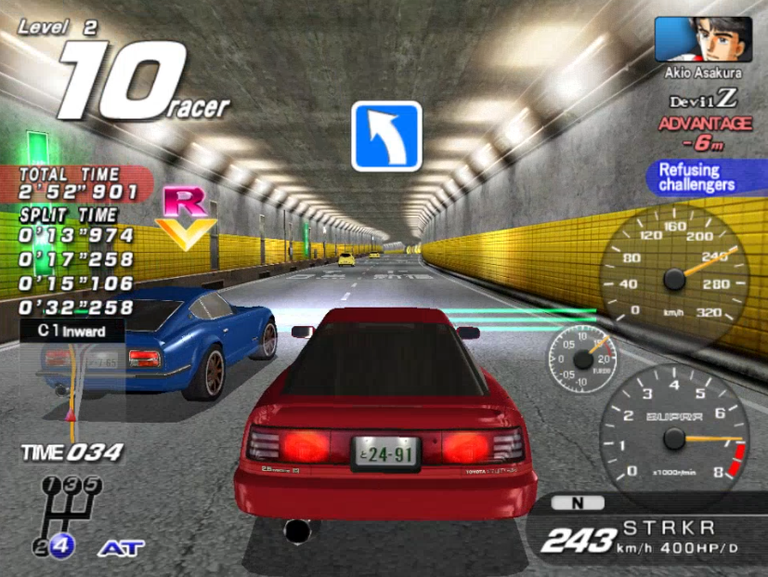
But at the same time, despite how unassuming the style of the game may look like with how its mainly about trying to tackle straights with occasional curves, not only the upgrades you get along the way give you an incentive to keep playing and see your car go even faster than before [which ties perfectly into Wangan Midnight's theming], but also as you approach harder challenges, goofy mistakes that make you fall behind will slowly but surely stop being acceptable to take if you want to take the lead.
And all of this is tied together with a very slick presentation, between the simple yet futuristic menus and the electronic soundtrack - made by Yuzo Koshiro of Streets of Rage fame...and also well known because of his songs made for this series of games.
My favorites so far out of the entire WMMT series would be Fun Loving Spirit, Glory Days and Give Up or Keep Trying Maxi5 - I still have to find a personal favorite from WMMT3 specifically, but maybe sooner or later I'll do.
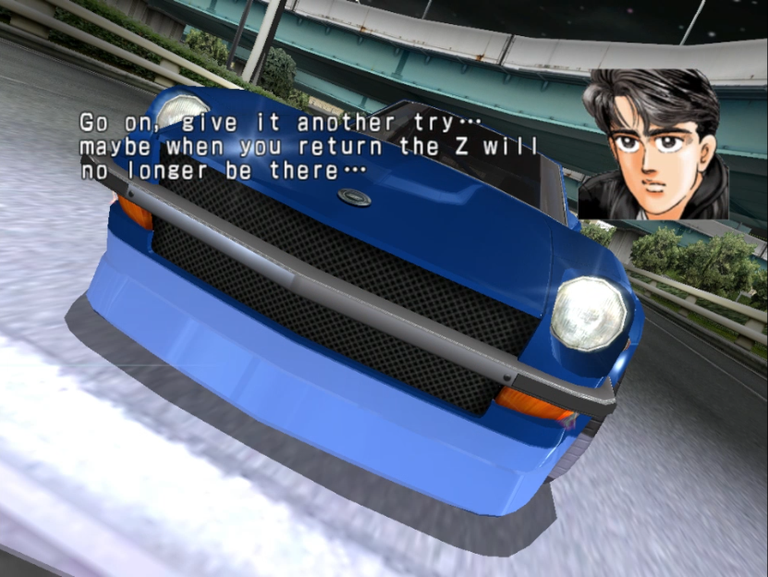
With how Wangan Midnight only got a single anime that adapted half of the manga [unlike Initial D, which got a mostly complete set of seasons for the entire thing] and how ID is often the more well known of the two, it is interesting that the most active legacy Wangan had over the years has been with Namco's Maximum Tune games of all things - as although Initial D still has an active arcade game to this day even though the anime ended long ago, at least most of the Arcade Stage games were actually made during several points where the anime was yet ongoing.
And more interestingly, is how even when the game may not seem all that thrilling with the sparse curves, it still had me hooked enough to write THIS much about it, as well as having tried and recorded several chapters of the story mode alongside trying once the 10 Outrun mode and those aforementioned four ghost battles.
So...yeah, it was worth setting it up at the end of the day.
It can be played on most PCs through Teknoparrot nowadays [again, was NEVER released outside of Arcades...so if you don't have a cabinet nearby, this is the only method] - although I can't guarantee that setting that up will be any easy. I have been thinking today about how a guide on how to do that would be useful for people out there, but no promises of anything until the day I happen to upload one as a video 😅
In any case, maybe I'll talk next time about Initial D Arcade Stage 6, which I had tried the night before this...but didn't have any screenshots at hand because the game didn't record properly.
Or maybe I'll retake that quest for 3-Star cups in Mario Kart DS. Who knows.
But until then, see you next time, and...
Thank you for reading!

Spanish translation with DeepL. All screenshots were captured by myself.
Español
Hace unos días, empecé a ver los primeros episodios del anime Wangan Midnight, considerado una especie de competidor de Initial D que se centra en un aspecto muy diferente de las carreras callejeras.
Dejando a un lado los entresijos de la historia de cada uno, las diferencias más claras son que Initial D trata sobre carreras callejeras en puertos de montaña, lo que lleva a esos momentos álgidos con derrapes, ya que dichos puertos de montaña tienen MUCHAS curvas, lo que lleva a muchos derrapes... y eso se traslada a los juegos de Initial D [o al menos, a los lanzados desde el primer Arcade Stage], que a menudo consisten en conseguir derrapar en esas curvas lo mejor que puedas.
Pero como Wangan Midnight se centra más bien en la conducción a alta velocidad en autopistas con coches muy tuneados [mezclado con historias sobre las implicaciones de las carreras callejeras, desde las cosas que sacrificas hasta las posibles consecuencias]... los juegos arcade también siguen este estilo de carreras más directo.

Sin embargo, aunque HAY algunos circuitos en estos juegos que tienen más curvas de lo habitual [como el puerto de montaña de Hakone y la línea C1], los juegos de Wangan suelen consistir en conducir rápido en rectas, teniendo que luchar para mantener el control de los corredores que van detrás de ti, así como afrontar curvas sutiles pero largas y un montón de tráfico conduciendo hacia ti o detrás de ti, ya sea en carreras de 1 contra 1 o de cuatro jugadores.
Por desgracia, al igual que los juegos de Initial D Arcade Stage, más allá de unos pocos juegos exclusivos para Japón para PS2 y PS3, los juegos de Wangan no están disponibles fuera de los salones recreativos. De hecho, los dos juegos de Wangan Midnight para PS2 y PS3 ni siquiera están relacionados con la serie Maximum Tune de Namco, sino que corren a cargo de Genki.
Bandai Namco mantendría esta serie de juegos de Wangan desde 2004 hasta hoy, con una nueva variante de la sexta entrada lanzada este año. Sin embargo, cuando a veces busco información sobre estos juegos, parece que hay algunos elogios ocasionalmente constantes para el tercer juego en particular.
Con esta entrada que tiene este atractivo interesante, así como el aterrizaje en la plaza en el equilibrio de los recursos para mí [más pequeño en tamaño que cada entrada en adelante y ser un título más antiguo por lo que debería funcionar bien en mi PC], terminé haciendo de esta la primera entrada que juego de esta serie.
¿Qué modos ofrece Maximum Tune 3?
Como alguien que no ha jugado a ninguno de los títulos anteriores, estoy ignorando cualquier actualización que pueda haber hecho de los dos primeros juegos, así como las actualizaciones DX / DX + para este juego y secuelas que vinieron después de él, así que esto va a ir a través de lo que el juego me ofreció a su valor nominal sin ningún contexto anterior o más reciente a la mano.
El juego tiene un sistema de tarjetas para llevar la cuenta de tu progreso en los modos para un jugador, así como el progreso que haces tuneando tu coche - algo visto en los juegos de Initial D, así como probablemente en muchos otros... aunque al menos este te permite cambiar la transmisión en cualquier momento que juegues en lugar de tener que esperar a una renovación como hacía Initial D Arcade Stage 3.


Los modos disponibles son:
- Modo Historia: Compites contra varios personajes del manga Wangan Midnight, siguiendo de alguna manera los acontecimientos del mismo. Fue interesante reconocer las líneas de las seis primeras carreras que hice debido a que había visto el anime.
- Ghost Battle: Compites cara a cara contra los fantasmas de otros jugadores, o al menos si juegas en un armario real y los jugadores dejan a sus fantasmas para competir contra ellos. Si no es el caso, correrás contra los fantasmas incluidos en el juego, pero al menos este modo te permite personalizar tu coche.
- 10 Outrun: A diferencia de los otros modos, aquí eliges un recorrido y un nivel de dificultad con diferentes corredores con un determinado rango de potencia... y luego tienes que dejar atrás a 10 corredores seguidos. Se ejecuta en que estarás contra un solo corredor y tienes que adelantarlo una vez [convenientemente mostrado con un rayo] para luego ser lanzado contra otro corredor.
- Time Attack: Es un modo contrarreloj. Elige un circuito y a por él.
Si quieres que tu coche vaya a toda velocidad, además de familiarizarte con el funcionamiento habitual del juego, tienes que jugar al Modo Historia, ya que con cada carrera exitosa tendrás la oportunidad de aumentar tu Potencia o Manejo.
Aunque si te centras demasiado en la Potencia en lugar de hacer ambas cosas a un ritmo equilibrado [y supongo que algo parecido pasa si ignoras la Potencia sobre el Manejo durante mucho tiempo], te saldrá esta chica llamándote la atención por eso en lugar de los personajes tuneadores que te dicen lo que estás consiguiendo.

Es gracioso, pero también es una pista de que las mejoras de Potencia desequilibradas repetidamente te darán menos HP hasta que consigas las mejoras de Manejo correspondientes para conseguir más potencia.
Cómo ruedan las cosas en la carretera

En primer lugar, tengo que mencionar el curioso detalle de que la mayoría de los coches de este juego son amarillos y llevan la marca de Namco con calcomanías de Pac-Man, lo que al principio parece una forma muy descarada de firmar estos juegos, pero resulta que en las versiones japonesas de este juego [y en la versión para exportación del primer juego arcade de WM] hay un texto que dice que los acontecimientos de este juego transcurren en el año 20XX, con estas grandes autopistas cortadas de alguna forma de las rutas habituales de la ciudad y ahora destinadas a carreras especiales.
...Pero no deja de ser gracioso que, con o sin contexto, veas todos estos coches de tráfico amarillo brillante circulando a tu lado.
Pasando a la jugabilidad, parece sencilla al principio, ya que la mayoría de las carreteras son rectas bastante largas y, si juegas en automático, sólo tienes la dirección y el acelerador/freno. Pero, por supuesto, las curvas a alta velocidad pondrán a prueba tu habilidad.

No sé cómo describir exactamente cómo se sienten los coches cuando giran bruscamente, pero se siente como un punto medio entre ser lo suficientemente bueno para girar en curvas de alta velocidad con las líneas y la velocidad correctas... pero ser lo suficientemente resbaladizo como para obligarte a tomarte tu tiempo aprendiendo a abordar esas curvas, ya que de lo contrario chocarás contra la valla y perderás velocidad.
Dado que el objetivo de este juego es mantener la velocidad, lo que se acentúa cuando tienes que bloquear a los coches que van detrás de ti, perder velocidad en las curvas es una forma fácil de permitir que un rival que te está respirando en la nuca te adelante. Pero si tienes la suerte de que venga un camión de tráfico por el lado por el que el rival intenta adelantarte, puedes recurrir a un truco muy descarado...

Los movimientos fuera del bolsillo y la persecución constante en general a mitad de carrera es lo que ha hecho que esos juegos tengan una base de fans en los salones recreativos que los tienen, ya que hay mucho tira y afloja entre los corredores que intentan adelantarse unos a otros debido a la longitud y al impulso de recuperación integrado para permitir que los jugadores que se quedan atrás puedan volver.
Así que sí, el tipo al que mandé contra un camión se recuperó rápido y se puso delante de mí después de eso... pero estaba condenado a reventar el motor en ese capítulo, así que se quedó atrás de todos modos [y por otro lado, a veces he golpeado coches de frente pero luego he podido alcanzar a los corredores de todos modos 😂 ].
Tirando manos contra fantasmas
Imaginaos mi reacción cuando uno de los fantasmas con los que podía competir aquí se llamaba DTogo.

Eso es una referencia a nada menos que Duke Togo... alias Golgo 13 - si el nombre no te suena, es un personaje de un manga MUY antiguo que descubrí en un juego de arcade... y de hecho había hablado de una película de él a principios de año.
¿Pero el fantasma en sí? Nada amenazador... Tenía 450 CV cuando probé el Ghost Battle, así que estaba un poco por encima de su peso, pero definitivamente no era tan rápido como esperaba.

Sin embargo, hice dos carreras contra fantasmas de nivel 3, que tenían 500 CV, por lo que dieron mejor batalla. Mientras que el fantasma de Hakone se desvaneció después de que consiguiera mantenerlo a raya durante los primeros minutos, el fantasma de 500CV del C1 dio una pelea algo justa hasta el final.
En cualquier caso, si quieres que tu coche tenga un aspecto diferente con piezas de personalización, la Batalla Fantasma es el lugar al que debes ir, ya que obtienes nuevas piezas para intercambiar por cada victoria.

Conclusión
Por un lado, es curioso que puedas superar la escala de potencia de los niveles más fáciles en los modos Ghost Battle y 10 Outrun si juegas lo suficiente al modo historia, pero es una mejor alternativa hacerlo que apuntar tontamente a los desafíos de dificultad alta sin un coche lo suficientemente duro.

Pero al mismo tiempo, a pesar de lo modesto que pueda parecer el estilo del juego, en el que se trata principalmente de afrontar rectas con curvas ocasionales, no solo las mejoras que obtienes por el camino te dan un incentivo para seguir jugando y ver cómo tu coche va incluso más rápido que antes [lo que encaja perfectamente con la temática de Wangan Midnight], sino que también, a medida que te acercas a retos más difíciles, los errores tontos que te hacen quedarte atrás dejarán de ser aceptables si quieres ir en cabeza.
Y todo ello unido a una presentación muy cuidada, entre los menús sencillos pero futuristas y la banda sonora electrónica, realizada por Yuzo Koshiro de Streets of Rage... y también conocido por sus canciones para esta serie de juegos.
Mis favoritas hasta ahora de toda la serie WMMT son Fun Loving Spirit, Glory Days y Give Up or Keep Trying Maxi5. Aún tengo que encontrar una favorita personal de WMMT3 en concreto, pero quizá tarde o temprano lo haga.

Teniendo en cuenta que Wangan Midnight sólo tuvo un único anime que adaptaba la mitad del manga [a diferencia de Initial D, que tuvo un conjunto de temporadas casi completo] y que ID es a menudo el más conocido de los dos, es interesante que el legado más activo que Wangan ha tenido a lo largo de los años haya sido con los juegos Maximum Tune de Namco - ya que aunque Initial D todavía tiene un juego arcade activo a día de hoy a pesar de que el anime terminó hace mucho tiempo, al menos la mayoría de los juegos Arcade Stage se hicieron durante varios puntos en los que el anime todavía estaba en curso.
Y lo que es más interesante, aunque el juego no parezca tan emocionante por sus escasas curvas, me enganchó lo suficiente como para escribir tanto sobre él, además de haber probado y grabado varios capítulos del modo historia junto a haber probado una vez el modo 10 Outrun y las mencionadas cuatro batallas fantasma.
Así que... sí, al final ha merecido la pena prepararlo.
Hoy en día se puede jugar en la mayoría de los PC a través de Teknoparrot [de nuevo, NUNCA salió a la venta fuera de los salones recreativos... así que si no tienes un armario cerca, este es el único método], aunque no puedo garantizar que sea fácil configurarlo. Hoy he estado pensando en que una guía de cómo hacerlo sería útil para la gente de por ahí, pero no prometo nada hasta el día que se me ocurra subir una en forma de vídeo 😅.
En cualquier caso, puede que la próxima vez hable de Initial D Arcade Stage 6, que probé la noche antes de esto... pero no tenía capturas a mano porque el juego no grababa bien.
O quizá retome la búsqueda de las copas de 3 estrellas en Mario Kart DS. Quién sabe.
Pero hasta entonces, hasta la próxima, y...
¡Gracias por leer!

Traducción al español hecha con DeepL. Todas las fotos capturadas por mí.
Me parece genial aunque no lo conocía! Por lo que leo tiene un enfoque mucho más cercano a Arcades occidentales de carreras (Como los NFS antiguos), quiero darle un chance!
Ghost racing now that does sound scary. However you pretty good controlling the wheel